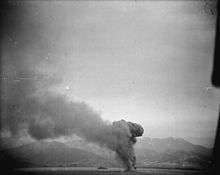Hampshire Yeomanry
| Hampshire Yeomanry | |
|---|---|
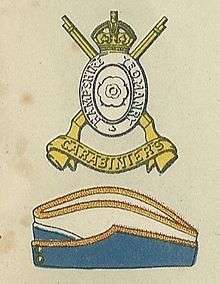 Badge and service cap as worn at the outbreak of World War II | |
| Active | 1794 – present day |
| Country |
|
| Branch |
|
| Type | Yeomanry |
| Role |
Cavalry Field Artillery Anti-Aircraft Artillery |
| Size | One Regiment |
| Engagements |
Second Boer War World War I World War II See battle honours below |
The Hampshire Yeomanry was a yeomanry cavalry regiment formed by amalgamating older units raised between 1794 and 1803 during the French Revolutionary Wars. It served in a mounted role in the Second Boer War and World War I, and in the air defence role during and after World War II. The lineage is continued by 295 (Hampshire Yeomanry) Battery and 457 (Hampshire Carabiniers Yeomanry) Battery, batteries of 106 (Yeomanry) Regiment Royal Artillery, part of the Army Reserve.
Early history
Between 1794 and 1803, a large number of cavalry units such as the North Hampshire Yeomanry Cavalry, the New Forest Volunteer Cavalry, the Fawley Light Dragoons and the Southampton Cavalry were raised in southern England as independent groups of Yeomanry. The Prime Minister, William Pitt the Younger, proposed that the English Counties form a force of Volunteer Yeoman Cavalry that could be called on by the King to defend the country against invasion or by the Lord Lieutenant to subdue any civil disorder within the country.[1] These units were brought together under the collective title of North Hampshire Regiment of Yeomanry Cavalry in 1834,[2] renamed Hampshire Regiment of Yeomanry Cavalry by 1848.[2] The Regiment adopted the title 'Carabiniers' in 1887.[2]
In 1908, after the formation of The Territorial Force, the regiment became known as the Hampshire Yeomanry (Carabiniers) with detachments in Winchester, Portsmouth, Bournemouth and Southampton.[2]
Second Boer War
On 13 December 1899, the decision to allow volunteer forces serve in the Second Boer War was made. Due to the string of defeats during Black Week in December, 1899, the British government realized they were going to need more troops than just the regular army, thus issuing a Royal Warrant on 24 December 1899. This warrant officially created the Imperial Yeomanry. The Royal Warrant asked standing Yeomanry regiments to provide service companies of approximately 115 men each. In addition to this, many British citizens (usually mid-upper class) volunteered to join the new regiment.[3]
The first contingent of recruits contained 550 officers, 10,371 men with 20 battalions and 4 companies,[4] which arrived in South Africa between February and April, 1900.[5] Upon arrival, the regiment was sent throughout the zone of operations. The Hampshire Yeomanry raised the 41st Company, 12th Battalion,[6] and the first company left Southampton on 31 January 1900, bound for Cape Town.[7]
The regiment was based at Hyde Close in Winchester at this time.[8]
World War I
| 1st South Western Mounted Brigade |
|---|
|
Organisation on 4 August 1914 |
|
Assigned units
|
|
Training attachments
|
|
In accordance with the Territorial and Reserve Forces Act 1907 (7 Edw. 7, c.9) which brought the Territorial Force into being, the TF was intended to be a home defence force for service during wartime and members could not be compelled to serve outside the country. However, on the outbreak of war on 4 August 1914, many members volunteered for Imperial Service. Therefore, TF units were split in August and September 1914 into 1st Line (liable for overseas service) and 2nd Line (home service for those unable or unwilling to serve overseas) units. Later, a 3rd Line was formed to act as a reserve, providing trained replacements for the 1st and 2nd Line regiments.[9]
1/1st Hampshire Yeomanry
The 1st Line regiment mobilized at Winchester in August 1914 as part of the 1st South Western Mounted Brigade and moved to the Portsmouth defences. In October it moved with the brigade to the Forest Row area, and in October 1915 to Eastbourne. In March 1916, the regiment was split up as divisional cavalry squadrons:[10]
- Regimental HQ and B Squadron joined 60th (2/2nd London) Division at Warminster on 26 April 1916 and landed at Le Havre on 25 June. Three days later, the RHQ joined IX Corps Cavalry Regiment along with C Squadron and A and B Squadrons, Royal Wiltshire Yeomanry at Bailleul. B Squadron was attached to XVII Corps Cavalry Regiment from 8 July and Cavalry Corps Troops from 5 September. It rejoined the regiment on 19 January 1917.
- A Squadron joined 58th (2/1st London) Division at Ipswich on 21 March 1916. It moved to the Sutton Veny area in July 1916 and landed at Le Havre on 20 January 1917. Five days later it rejoined the regiment in IX Corps Cavalry Regiment at Bailleul.
- C Squadron joined 61st (2nd South Midland) Division at Ludgershall on 18 March 1916 and landed at Le Havre on 25 May. From 31 May to 16 June it was attached to the 1st Cavalry Division before rejoining the regiment.
IX Corps Cavalry Regiment was formed on 28 June 1916 with the RHQ and C Squadron of the Hampshire Yeomanry, and A and B Squadrons, Royal Wiltshire Yeomanry at Bailleul. In November the Wiltshire squadrons departed and A and B Squadrons, Hampshire Yeomanry joined in January 1917 to complete the regiment.[10]
The regiment left IX Corps on 25 July 1917 and on 26 August it was dismounted and sent to No. 3 Infantry Base Depot at Rouen for training as infantry.[10] On 27 September 1917, 12 officers and 307 men were absorbed into the 15th (Service) Battalion (2nd Portsmouth), Hampshire Regiment at Caëstre which became 15th (Hampshire Yeomanry) Battalion, Hampshire Regiment. The Battalion was in 122nd Brigade, 41st Division. On 12 November 1917, it moved to the Italian Front with the division, arriving at Mantua on 17 November. It returned to the Western Front in between 1 and 5 May 1918 and remained there, in 122nd Brigade, 41st Division, until the end of the war. By the Armistice it was at Neukerke, south of Audenarde, Belgium.[11]
2/1st Hampshire Yeomanry
The 2nd Line regiment was formed at Winchester in October 1914. In May 1915 it was with 2/1st South Western Mounted Brigade at Calne and moved in September to Canterbury, to Maresfield in October and to Tiptree in March 1916.[10] On 31 March 1916, the remaining Mounted Brigades were ordered to be numbered in a single sequence[12] and the brigade became the 15th Mounted Brigade and joined 4th Mounted Division.[10]
In July 1916, the regiment was converted to a cyclist unit in 6th Cyclist Brigade, 2nd Cyclist Division; in August it was at Preston near Canterbury. In November 1916 it moved to Ipswich and the regiment was merged with the 2/1st Berkshire Yeomanry to form 11th (Hampshire and Berkshire) Yeomanry Cyclist Regiment in 4th Cyclist Brigade. In February 1917 it was at Coltishall and was part of 5th (Hampshire and West Somerset) Yeomanry Cyclist Regiment (with 2/1st West Somerset Yeomanry) in 2nd Cyclist Brigade. In March 1917 it resumed its identity as 2/1st Hampshire Yeomanry and by October 1917 it was at Reepham, Norfolk. On 16 May 1918, the regiment landed in Dublin and was posted to Maryborough (now Port Laoise) with companies at Tullamore and Birr, still in 2nd Cyclist Brigade; there was no further change before the end of the war.[10]
3/1st Hampshire Yeomanry
The 3rd Line regiment was formed in 1915; in the summer it was affiliated to the 11th Reserve Cavalry Regiment at Tidworth. Early in 1917 it was absorbed into the 4th Reserve Cavalry Regiment, at Aldershot. By 1918 it had left the 4th Reserve Cavalry Regiment when the 1st Line had been converted to infantry. It joined the 4th (Reserve) Battalion of the Hampshire Regiment at Larkhill.[10]
Between the wars
Artillery conversion
On 1 June 1920, the Regiment was reconstituted in the Territorial Army with HQ at Winchester. Following the experience of the war, it was decided that only the fourteen most senior yeomanry regiments would be retained as horsed cavalry,[13] with the rest being transferred to other roles.[14] As a result, the regiment was converted into a battery of the Royal Field Artillery (RFA) in 1920 and amalgamated with the Hampshire Royal Horse Artillery to form 7th (Hampshire) Army Brigade, RFA. When the TF was converted into the Territrial Army (TA) the following year, it was redesignated 95th (Hampshire Yeomanry) Army Brigade, RFA. In 1924 the RFA was subsumed into the Royal Artillery (RA) and the unit became an Army Field Brigade, RA, with the following organisation:[2][15][16][17][18][19]
- HQ at Hyde Close, Winchester
- 377th (Hampshire) at Hyde Close, Winchester
- 378th (Hampshire Yeomanry) Bty at Hamilton House, Commercial Road, Southampton
In 1927 the 55th (Wessex) Field Brigade was completely reorganised and its two Hampshire batteries (originally constituting 2nd (Wessex) Brigade, RFA) transferred to the 95th. The expanded unit was no longer an 'Army' field brigade, but took the 55th's place in 43rd (Wessex) Division, with the following organisation:[2][16][20][21]
- HQ at Hyde Close, Winchester
- 377th (Winchester) Field Bty at Hyde Close, Winchester
- 378th (Hampshire RHA) Field Bty at Hamilton House, Commercial Road, Southampton
- 218th (Hampshire) Field Bty at Bournemouth – from 55th (Wessex) Fd Bde
- 219th (Hampshire) Field Bty (Howitzers) at Newport, Isle of Wight – from 55th (Wessex) Fd Bde
The battery titles were quite fluid at this time: in 1929, 219 Bty was redesignated 'Isle of Wight'; later it moved to Albert Road, Cosham, and took 'Cosham' as its subtitle. By 1934, 218 Bty had been redesignated 'Bournemouth', and in 1937 the brigade dropped the 'Yeomanry' part of its subtitle.[2][15]
Anti-Aircraft Conversion
At the end of the 1930s when war with Germany was again imminent, the need for improved anti-aircraft (AA) defences for Britain's cities became apparent, and a programme of converting existing TA units was pushed forward. In October 1937 95th Field Brigade became 72nd (Hampshire) Anti-Aircraft Brigade, Royal Artillery (Anti-Aircraft Regiment from 1939) with the following organisation:[2][15][16]
- Regimental HQ at Hamilton House, Commercial Road, Southampton
- 217th (Hampshire Carabiniers) AA Battery at Hyde Close, Winchester
- 218th (Hampshire RHA) AA Battery at Southampton
- 310th AA Battery, formed January 1939 at Parkstone, Dorsetshire
(The two former Wessex batteries transferred to 57th (Wessex) AA Brigade and 94th (Queen's Own Dorset Yeomanry) Field Brigade.)[2][15][16]
World War II
Mobilisation
The TA's AA units were mobilised on 23 September 1938 during the Munich Crisis, with units manning their emergency positions within 24 hours, even though many did not yet have their full complement of men or equipment. The emergency lasted three weeks, and they were stood down on 13 October.[22] In February 1939 the existing AA defences came under the control of a new Anti-Aircraft Command. In June, as the international situation worsened, a partial mobilisation of the TA was begun in a process known as 'couverture', whereby each AA unit did a month's tour of duty in rotation to man selected AA gun positions. On 24 August, ahead of the declaration of war, AA Command was fully mobilised at its war stations.[23]
72nd (Hampshire) AA Regiment mobilised in 35th AA Brigade under 5th AA Division.[24][25] 35 AA Brigade was responsible for the Gun Defence Area (GDA) protecting the city and naval base of Portsmouth. In September 1939, the brigade had 29 heavy AA guns round the city.[26] During 1940 the AA regiments of the RA were designated 'Heavy AA'to distinguish them from the newer Light AA units being formed.[27] By July 1940, when the Battle of Britain began, there were 44 HAA guns deployed in the Portsmouth GDA.[28]
Battle of Britain and Blitz
The regiment was heavily engaged throughout the Battle of Britain. A few bombers got through to Portsmouth on 10 July,[29] and the Portsmouth and Southampton AA guns were in action on 15 August, claiming one 'kill'.[30] Again, on 18 August, German air raids crossed Southern England and attacked RAF airfields in the afternoon. The guns of 35 AA Bde and its neighbours were in action and accounted for 23 enemy aircraft.[31] On 24 August a raid eluded RAF Fighter Command's fighters and bombed Portsmouth city and dockyard badly, killing over 100 people despite the efforts of the AA guns, although another raid two days later was driven off by fighters and AA fire, and only dropped a few bombs on the outskirts of the city.[32][33] This was the start of the Portsmouth Blitz.
After 15 September, the intensity of Luftwaffe daylight attacks fell, and the emphasis switched to night bombing of industrial towns (The Blitz). Portsmouth was a major target: during a succession of attacks, two bombs fell on a gun position of 35 AA Bde, killing an officer and 10 men, wrecking the command post and one gun. Two of the remaining guns continued to fire by improvised methods.[34] The city was badly bombed on the nights of 5 December 1940, 10 January, 10 March, 17 and 27 April 1941.[35][36][37]
72nd (Hampshire) HAA Rgt remained with 35 AA Bde throughout this period, and was joined by a newly-formed 393 HAA Bty.[38][39][40] In August 1941, 310 HAA Bty left to provide an experienced cadre for the newly-raised 131st HAA Rgt, a 'Mixed' unit including women of the Auxiliary Territorial Service that was forming in 35 AA Bde, while 217 HAA Bty was attached to 27 (Home Counties) AA Bde, which controlled the searchlight array round Portsmouth.[41][42]
Mobile training
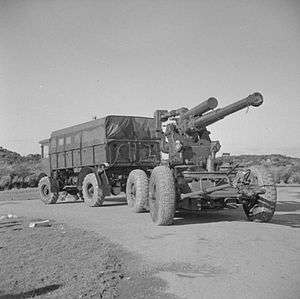
In January 1942, 72nd (Hampshire) HAA Rgt left AA Command and joined the War Office Reserve with 217, 218 and 393 HAA Btys.[43] This was usually a precursor to mobile training for service overseas. In between training, these units were lent back to AA Command, and by May the regiment was with 28 (Thames & Medway) AA Bde in 6 AA Division protecting the approaches to London, then in June moved to newly-formed 71 AA Bde in 6 AA Division. In July 1942 it become an unbrigaded regiment, leaving AA Command entirely by mid-August when it came under direct War Office control.[44][45]
In the autumn of 1942 the regiment, equipped with 24 3.7-inch guns, was joined by its own HAA Signal Section of the Royal Corps of Signals (RCS) and by November it was fully organised for mobile operations with the following composition:[46]
- 217 HAA Bty
- 218 HAA Bty
- 393 HAA Bty
- 72 HAA Rgt Signal Section, RCS
- 72 HAA Workshop, Royal Electrical and Mechanical Engineers
- 72 HAA Rgt Platoon, Royal Army Service Corps
North Africa
72nd (Hampshire) HAA Rgt sailed from the River Clyde in late October as part of 52 AA Bde in First Army for Operation Torch, the Allied landings in North Africa. AA units trained in amphibious operations were to land in the assault phase of the operation, followed by the mobile units of 52 AA Bde. After covering the landing beaches, ports and airfields, the brigade would then follow First Army's advance eastwards, leaving other AA formations to cover the bases in the rear. The invasion force began landing on 8 November 1942, with V Corps of First Army landing round Algiers. After the initial landings were complete, V Corps sent a series of infantry and commando groups eastwards on 9 November and 52 AA Bde HQ landed.[47][48][49]
Leaving some batteries to unload and set up an 'Inner Artillery Zone' (IAZ) around Algiers, 52 AA Bde began a long march eastwards. The need to get AA units forward quickly to protect the vital airfields had been foreseen, and one of 72nd HAA Rgt's batteries went on by sea direct to Bougie. The Axis air forces reacted quickly and 72nd HAA Rgt suffered equipment losses when the liner SS Cathay was sunk off Bougie. However, by 12 November V Corps' leading troops had covered 300 miles (480 km) and Bône had been secured by a parachute drop. Bône now came under intense air attack. At first it was only protected by LAA guns, but a battery of 72nd HAA Rgt came up, even though it had lost its gun-laying (GL) radar set in a torpedoed ship. On 21 November the AA gunners at Bône fought raids by Junkers Ju 88 bombers that set buildings and stores ablaze, and destroyed the AA gunners' small stock of vehicles.[50]
As the Tunisian Campaign developed, forward movement was slowed by terrain and shortages: most units in 'Torch' had only 50 per cent of their vehicle establishment, and AA units frequently had to lend theirs to other units for urgent transport tasks. By the end of November the AA deployment had reached planned levels, but V Corps' advance had been held by the rapid arrival of German forces. As the Allies built up strength for a renewed advance, the emphasis for the AA units turned to defence for the ports and airfields against heavy attacks by the Luftwaffe. By January the arrival of reinforcements allowed 52 AA Bde to concentrate on providing front line support for V Corps. The brigade was prepared to follow up any breakthrough towards Tunis.[51][52]
During January 1943, batteries of 72nd HAA Rgt were variously deployed:[53]
- Constantine airfield
- Philippeville port and airfield: (with a Troop of 71st (Forth) HAA Rgt)
- Youks-les-Bains Airfield
- Thelepte Airfield
By mid-March 1943, the regiment's deployments included:[54]
- Tebessa Airfield: 11⁄2 Btys (with a Bty of 63rd LAA Rgt)
- Constantine: 1 Trp
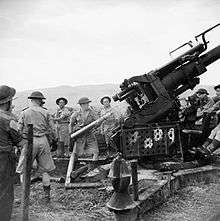
As the fighting continued into April, the HAA guns in forward positions were increasingly used to fire on ground targets to supplement the medium artillery. When IX Corps came into the line for the 'dogfight' to penetrate the mountain passes near Fondouk, 72nd HAA Rgt was assigned to it and was heavily engaged in both the AA and ground roles. In one week, 20–27 April, the regiment shot down seven enemy aircraft for the expenditure of 1022 rounds, but fired many more low-angle rounds at ground targets, which damaged the elevating and balancing gear of the 3.7-inch guns.[55]
By the beginning of May, First Army was ready for its final assault on Tunis, Operation Vulcan. The AA plan for 'Vulcan' was straightforward: 52 AA Bde held a number of AA units including 72nd HAA Rgt on their wheels and ready to move into Tunis immediately behind the leading battle groups. Delayed by a German counter-attack, the assault went in on 6 May and covered 15 miles (24 km) on the first day. The leading British armoured units entered Tunis on the afternoon of 7 May. After a series of conflicting reports from the city, 52 AA Bde was called forward and 72nd HAA Rgt immediately deployed in the city. In fact, Tunis was not yet clear of the enemy and some AA advance parties had to flush out resistance. The German forces surrendered on 12 May.[56][57]
The role of the AA units turned to protecting the North African embarkation ports for the forthcoming Allied invasion of Sicily (Operation Husky).[58]
Italy
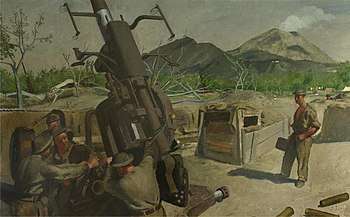
72nd (Hampshire) HAA Regiment was not employed in 'Husky', nor in the assault phase of the subsequent Allied invasion of the Italian mainland, but it formed part of 22 AA Bde, which landed and took over the air defence of Naples in late October 1943. Naples was a difficult city to defend against air attack, with a large anchorage, port facilities and airfields such as Bagnoli, all overlooked by mountains, but 22 AA Bde established a fully integrated layout of HAA and LAA guns with early warning and gun-laying radar, and involving US Army and Italian Co-belligerent Army units. This was necessitated by the scale of the Luftwaffe 's attempts to disrupt the flow of supplies through the port. On 5 November alone, morenthan 100 aircraft raided the port and four were brought down by AA fire. On 9 November two out of 30 were shot down, and on 26 November, in conjunction with fighter aircraft, nine hostiles were destroyed. The port was damaged but continued working. The AA strength around Naples reached its peak in November 1943.[59][60][61]
The Luftwaffe began a new series of raids against Naples in March 1944, but after May the AA strength there could be reduced, and the AA gunners settled to a regular programme of routine manning and training, interspersed with garrison duties such as transporting stores from the docks. The last spasmodic raids occurred in July and August.[62]
72nd HAA Rgt remained in 22 AA Bde in the Naples area until October 1944, but by then the threat from the Luftwaffe was diminishing and tere was an urgent need for manpower in other areas. A number of AA units including 72nd HAA Rgt began to be disbanded in the latter part of 1944, and the regiment passed into suspended animation by January 1945.[16][63]
Postwar
In 1947, with the revival of the Territorial Army, the Hampshire Yeomanry was reformed as 295th (Hampshire Carabineers) Heavy Anti-Aircraft Regiment, RA (TA). It formed part of 100 Army Group Royal Artillery (TA) until this formation was disbanded on 9 September 1948.[64]
In 1963 the Regiment amalgamated with the 457 (Wessex) Heavy Air Defence Regiment RA (TA). The two units were renamed the 457th (Wessex) Heavy Air Defence Regiment, RA (Hampshire Carabiniers Yeomanry); this gave the Regiment the longest title in the army, and it took on a new role converting from traditional anti-aircraft guns to using the Thunderbird Anti-Aircraft Missile. The Regiment had the distinction of firing the last three missiles in the UK before Thunderbird was decommissioned. On 31 March 1967 the Regiment was disbanded on the demise of the Territorial Army and its replacement the TAVR.
The regiment was reformed in 1992 when the Hampshire Yeomanry returned as the 227 (Hampshire Yeomanry) Amphibious Engineer Squadron, Royal Engineers. Again this was a very short-lived incarnation as, after the Strategic Defence Review in 1999, the unit was re-roled as artillery with the formation of 457 (Hampshire Yeomanry) Battery in 106th (Yeomanry) Regiment Royal Artillery. The battery was based at Millbrook, Southampton and equipped with high velocity missiles (HVM).[65]
Under Army 2020 457 (Hampshire Carabiniers Yeomanry) Battery was re-equipped at Southampton with high velocity missiles mounted on Stormer vehicles and 295 (Hampshire Yeomanry) Battery was formed at Portsmouth and equipped in the same way. Both batteries form part of 106th (Yeomanry) Regiment.[65]
Battle honours
The Hampshire Yeomanry has been awarded the following battle honours:[2]
- Second Boer War
- First World War
Messines 1917, Somme 1918, St. Quentin, Bapaume 1918, Arras 1918, Ypres 1918, Courtrai, France and Flanders 1916–17 '18, Italy 1917–18
- Second World War
The Royal Artillery was present in nearly all battles and would have earned most of the honours awarded to cavalry and infantry regiments. In 1833, William IV awarded the motto Ubique (meaning "everywhere") in place of all battle honours.[66]
See also
References
- ↑ "Worcestershire Yeomanry Cavalry (1794-1994)". Archived from the original on 15 August 2004.
- 1 2 3 4 5 6 7 8 9 10 "Hampshire Yeomanry (Carabiniers) at regiments.org by T.F.Mills". Archived from the original on 16 April 2007. Retrieved 10 May 2014.
- ↑ "Boer War Notes". Retrieved 11 June 2007.
- ↑ "Imperial Yeomanry at regiments.org by T.F.Mills". Archived from the original on 29 May 2007. Retrieved 29 May 2007.
- ↑ "Boer War - Imperial Yeomanry Battalions". Retrieved 3 July 2007.
- ↑ "Anglo boer war". Archived from the original on 14 July 2008.
- ↑ "The War - The Auxiliary Forces, Departure of Yeomanry from Southampton". The Times (36054). London. 1 February 1900. p. 10.
- ↑ "Winchester". The Drill Hall Project. Retrieved 25 December 2017.
- ↑ Rinaldi 2008, p. 35
- 1 2 3 4 5 6 7 James 1978, p. 20
- ↑ James 1978, p. 80
- ↑ James 1978, p. 36
- ↑ Mileham 1994, p. 48
- ↑ Mileham 1994, p. 50
- 1 2 3 4 Army List.
- 1 2 3 4 5 Litchfield, p. 95.
- ↑ Farndale, Annex K.
- ↑ Litchfield, p. 89.
- ↑ Litchfield, Appendix VII.
- ↑ Litchfield, pp. 93.
- ↑ Titles & Designations 1927.
- ↑ Routledge, pp. 62–3.
- ↑ Routledge, pp. 65–6, 371.
- ↑ Routledge, Table LX, p. 378.
- ↑ AA Command 3 September 1939 at Patriot Files
- ↑ Routledge, Table LIX, p. 377,
- ↑ Litchfield.
- ↑ Farndale, p. 106.
- ↑ Collier, Chapter 10.
- ↑ Coller, Chapter 12.
- ↑ Routledge, p. 383.
- ↑ Collier, Chapter 13.
- ↑ Collier, Appendix XIV.
- ↑ Routledge, p. 395.
- ↑ Collier, Chapter 17.
- ↑ Collier, Appendix XXX.
- ↑ Collier, Appendix XXXI.
- ↑ Farndale, Annex D.
- ↑ Routledge, Table LXV, p. 396.
- ↑ Order of Battle of Non-Field Force Units in the United Kingdom, Part 27: AA Command, 12 May 1941, The National Archives (TNA), Kew, file WO 212/79.
- ↑ Order of Battle of Non-Field Force Units in the United Kingdom, Part 27: AA Command, 2 December 1941, TNA file WO 212/80.
- ↑ Farndale, Annex M.
- ↑ Order of Battle of the Field Force in the United Kingdom, Part 3: Royal Artillery (Non-Divisional units), 22 October 1941 with amendments, TNA files WO 212/6 and WO 33/1883.
- ↑ Order of Battle of Non-Field Force Units in the United Kingdom, Part 27: AA Command, 14 May 1942, with amendments, TNA file WO 212/81.
- ↑ Order of Battle of the Field Force in the United Kingdom, Part 3: Royal Artillery (Non-Divisional Units), 14 August 1942, with amendments, TNA files WO 212/7 and WO 33/1927.
- ↑ Order of Battle of the Field Force in the United Kingdom, Part 3: Royal Artillery (Non-Divisional Units), 22 November 1942, TNA file WO 212/8.
- ↑ Joslen, p. 465.
- ↑ Playfair & Molony, pp. 137-46, 165.
- ↑ Routledge, pp. 176–9 ; Map 8.
- ↑ Routledge, pp. 177–81.
- ↑ Playfair & Molony, pp. 165–82.
- ↑ Routledge, pp. 180–2.
- ↑ Routledge, Table XXX, p. 188.
- ↑ Routledge, Table XXXI, p. 189.
- ↑ Routledge, pp. 184–5.
- ↑ Playfair & Molony, pp. 430, 452–9.
- ↑ Routledge, pp. 185–6; Map 9; Table XXXII, p. 190.
- ↑ Routledge, p. 186.
- ↑ Joslen, p. 467.
- ↑ "British GHQ, Army Group, Army and Corps Troops Italian and Balkan Campaign 1943-1945" (PDF). The Nafziger Collection of Orders of Battle. Retrieved 4 November 2017.
- ↑ Routledge, pp. 274-7, 287.
- ↑ Routledge, p. 288.
- ↑ Routledge, Table XLIV, p. 293; Table XLVII, pp. 296–7.
- ↑ Litchfield, Appendix 5.
- 1 2 "106th Regiment, Royal Artillery". Ministry of Defence. Retrieved 4 November 2017.
- ↑ "Royal Regiment of Artillery at regiments.org by T.F.Mills". Archived from the original on 29 June 2007. Retrieved 15 July 2007.
Bibliography
- Basil Collier, History of the Second World War, United Kingdom Military Series: The Defence of the United Kingdom, London: HM Stationery Office, 1957.
- Gen Sir Martin Farndale, History of the Royal Regiment of Artillery: The Years of Defeat: Europe and North Africa, 1939–1941, Woolwich: Royal Artillery Institution, 1988/London: Brasseys, 1996, ISBN 1-85753-080-2.
- James, Brigadier E.A. (1978). British Regiments 1914–18. London: Samson Books Limited. ISBN 0-906304-03-2.
- Lt-Col H.F. Joslen, Orders of Battle, United Kingdom and Colonial Formations and Units in the Second World War, 1939–1945, London: HM Stationery Office, 1960/Uckfield: Naval & Military Press, 2003, ISBN 1-843424-74-6.
- Norman E.H. Litchfield, The Territorial Artillery 1908–1988 (Their Lineage, Uniforms and Badges), Nottingham: Sherwood Press, 1992, ISBN 0-9508205-2-0.
- Mileham, Patrick (1994). The Yeomanry Regiments; 200 Years of Tradition. Edinburgh: Canongate Academic. ISBN 1-898410-36-4.
- Maj-Gen I.S.O. Playfair & Brig C.J.C. Molony, "History of the Second World War, United Kingdom Military Series: The Mediterranean and Middle East, Vol IV: The Destruction of the Axis forces in Africa, London: HMSO, 1966/Uckfield, Naval & Military Press, 2004, ISBN 1-845740-68-8
- Rinaldi, Richard A (2008). Order of Battle of the British Army 1914. Ravi Rikhye. ISBN 978-0-97760728-0.
- Brig N.W. Routledge, History of the Royal Regiment of Artillery: Anti-Aircraft Artillery 1914–55, London: Royal Artillery Institution/Brassey's, 1994, ISBN 1-85753-099-3.
- Titles and Designations of Formations and Units of the Territorial Army, London: War Office, 7 November 1927 (RA sections also summarised in Litchfield, Appendix IV).
External links
- Baker, Chris. "The Hampshire Yeomanry". The Long, Long Trail. Retrieved 6 April 2015.
- Hampshire Yeomanry (Carabiniers) at regiments.org by T.F.Mills at the Wayback Machine (archived 15 July 2007)
- Orders of Battle at Patriot Files
